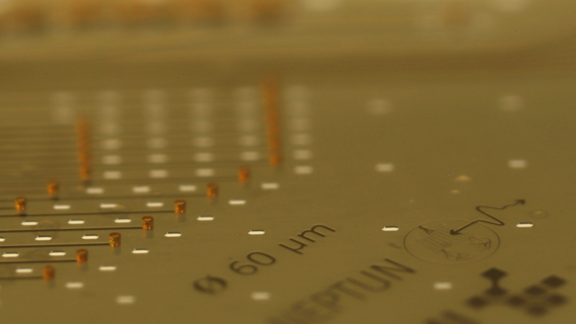
Bioelectronic Implants

Next Generation Cellular and Organotypic Assays
Assembly, encapsulation and test engineering of bioelectronic implants
Bioelectronic implants serve as diagnostic, monitoring and therapeutic tools for a wide range of clinical challenges arising from injuries or pathological conditions. These implants enable more precise and advanced interaction at the cellular and molecular level. They use not only electrical impulses but also biochemical and biophysical signals to control, monitor or modulate specific biological functions. Bioelectronic implants are able to both receive signals from the biological system and send targeted signals to the biological environment. This bidirectional communication enables dynamic adaptation to the needs of the organism. Bioelectronic implants combine technologies from biology, electronics and material sciences to enable seamless communication between the implant and the body. They may contain sensors that detect biochemical signals or physiological parameters, and actuators that use electrical impulses or other forms of energy to trigger biological reactions. They can achieve specific effects through targeted stimulation of nerves or tissue. This opens up a broad spectrum of advanced applications in diagnostic and therapeutic medicine as well as in biotechnology.
Our research in the field of bioelectronic implants focuses on the following pillars
- Design and Fabrication: Innovating new implant architectures
- Sensing Technologies: Pioneering sensor development for enhanced readings
- Biocompatibility: Ensuring implant encapsulation for biological systems
- Electronic Interfaces: Bridging the gap between implants and measurement apparatuses
- Durability Testing: Establishing protocols to ascertain prolonged implant functionality and stability

Central to our endeavors is the extensive exploration of flexible microelectrode arrays (MEAs) tailored for diverse applications. The device targeting necessitates evolving implantation techniques to aptly access the designated region. Presently, we solely focus on device design for in-vivo proof-of-concept animal measurements, seeking to validate novel measurement paradigms and implantation strategies.
Fabrication Equipment
- Microelectrode arrays
- Parylene-C Encapsulation (Comelec)
Characterization
- Profilometer (Bruker)
- Laser scanning microscope (Keyence)
- Scanning electron microscope (Zeiss)
- Potentiostat (Gamry, AMTEK, Biologic)
- Short/long term encapsulation testing
- Short/long term device validation
Projects
NEPTUN- Mikroimplantate für geregelte Stimulation viszeraler Nerven
PanaMEA - Pankreas-Implantat zur Blutzuckerüberwachung
Sealant- Entwicklung und Test von Verkapselungstechnologien für innovative miniaturisierte aktive Implantate





